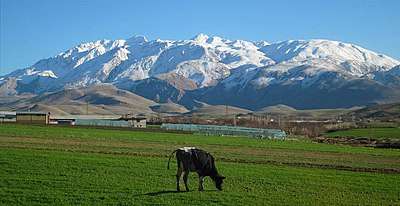Oshtorankuh
Oshtorankuh (Persian: اشترانکوه) is a mountain that is located about 15 kilometres south of the city of Dorud in Lorestan Province in Iran.[1] With an elevation of 4050 metres, the Oshtorankuh is the highest mountain in Lorestan Province. Stretched in a northwest-southeast direction, the Oshtorankuh is situated in the Zagros Mountains and is among the high mountains of this range. The ِDez Dam start in the Zagros mountains near the Oshtorankuh .


Etymology
Oshtorankuh means “mountain of camels” in Persian and is made of two words, “oshtoran” which is the plural form of ”oshtor” or “shotor” meaning “camel” with the plural suffix “an” and “kuh” that means “mountain”. So because of its eight high peaks of more than 4000 metres that look like a caravan of camels, this mountain is called “Oshtorkuh” or “Oshtorankuh”.
Geology
Situated in the Lorestan geologic and structural zone of Iran, the Oshtorankuh is mainly made of Jurassic-Cretaceous dolomitic limestone.[2]
Climatology
Being a high mountain with snow-covered peaks and glacial valleys, the Oshtorankuh has a cold mountain climate with cold winters and cool summers.
Plant and animal life
Mountain pistachio, rhubarb, goat's thorn and wild plants are among the various forms of the mountain's vegetation. Animals include brown bears, foxes, grey wolves, boars, hyenas, squirrels, wild cats and mountain goats. Eagles, quails, and owls are among different birds found in the vicinity of this mountain. The “Oshtorankuh Protected Nature Reserve” is one of the protected nature reserves of Iran which includes a region of 98,000 hectares. The famous Lake Gahar is within this protected region. The different tribes of Bakhtiyari Charlang branch live in the foothills of the Oshtorankuh.
References
- Comprehensive Map of Iran, Microsoft Encarta Interactive World Atlas 2001, Microsoft Corporation
- Geological Map of Iran, National Geoscience Database of Iran, www.ngdir.ir